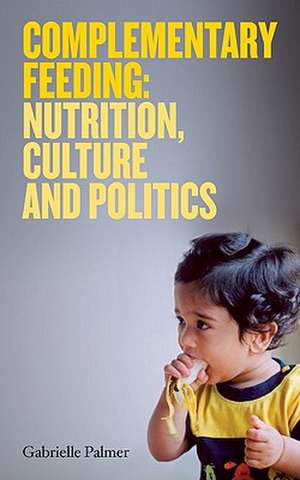Complementary Feeding: Nutrition, Culture and Politics
Autor Gabrelle Palmeren Limba Engleză Paperback – 30 apr 2011
Preț: 57.40 lei
Nou
Puncte Express: 86
Preț estimativ în valută:
10.98€ • 11.40$ • 9.18£
10.98€ • 11.40$ • 9.18£
Carte disponibilă
Livrare economică 22 februarie-08 martie
Preluare comenzi: 021 569.72.76
Specificații
ISBN-13: 9781905177424
ISBN-10: 1905177429
Pagini: 128
Dimensiuni: 136 x 217 x 8 mm
Greutate: 0.18 kg
Editura: Pinter & Martin Ltd
ISBN-10: 1905177429
Pagini: 128
Dimensiuni: 136 x 217 x 8 mm
Greutate: 0.18 kg
Editura: Pinter & Martin Ltd
Notă biografică
Gabrielle Palmer is a nutritionist and a campaigner. She was a breastfeeding counsellor in the 1970s and helped establish the UK pressure group Baby Milk Action. In the early 1980s she lived and worked as a volunteer in Mozambique. She has written, taught and campaigned on infant feeding issues, particularly the unethical marketing of baby foods. In the 1990s she co-directed the International Breastfeeding: Practice and Policy course at The Institute of Child Health in London until she went to live in China for two years. She has worked independently for various health and development agencies, including serving as HIV and Infant Feeding Officer for UNICEF New York. She recently worked at The London School of Hygiene and Tropical Medicine where she had originally studied nutrition. She is a mother and a grandmother. She retired from active campaigning at the end of 2009.
Cuprins
Introduction Acknowledgements Foreword PART ONE: THE BIG PICTURE 1 Entitlement to food 2 Entitlement to water 3 Medicalising undernutrition and poverty 4 Fair distribution 5 What is complementary feeding? 6 Politics 7 Nutrition PART TWO: A CLOSER LOOK 8 Food and nutrition: an historical perspective 9 Evolution and food systems 10 Salty, sweet and fat: the human drives for taste 11 Human plumpness 12 The timing of complementary feeding 13 What did prehistoric young children eat? 14 Are cereals appropriate foods for babies? 15 A word about animal milk 16 Why don't we give our babies molluscs and insects? 17 Cultural and religious beliefs PART THREE: PROCESSES FOR CHANGE 18 The language of food 19 Is a 'local' diet possible and good enough for infants and young children? 20 A lesson from history: the example of wartime UK 21 A contemporary lesson: the US Special Supplemental Nutrition Program for Women, Infants and Children (WIC) 22 The majority world Afterword: health for all? APPENDICES I Insects and other invertebrates as food II A nutrient example: iron III Additional information on the British 'Food for Victory' campaign IV Additional information on the Special Supplemental Nutrition Program for Women, Infants and Children (WIC) References Index
